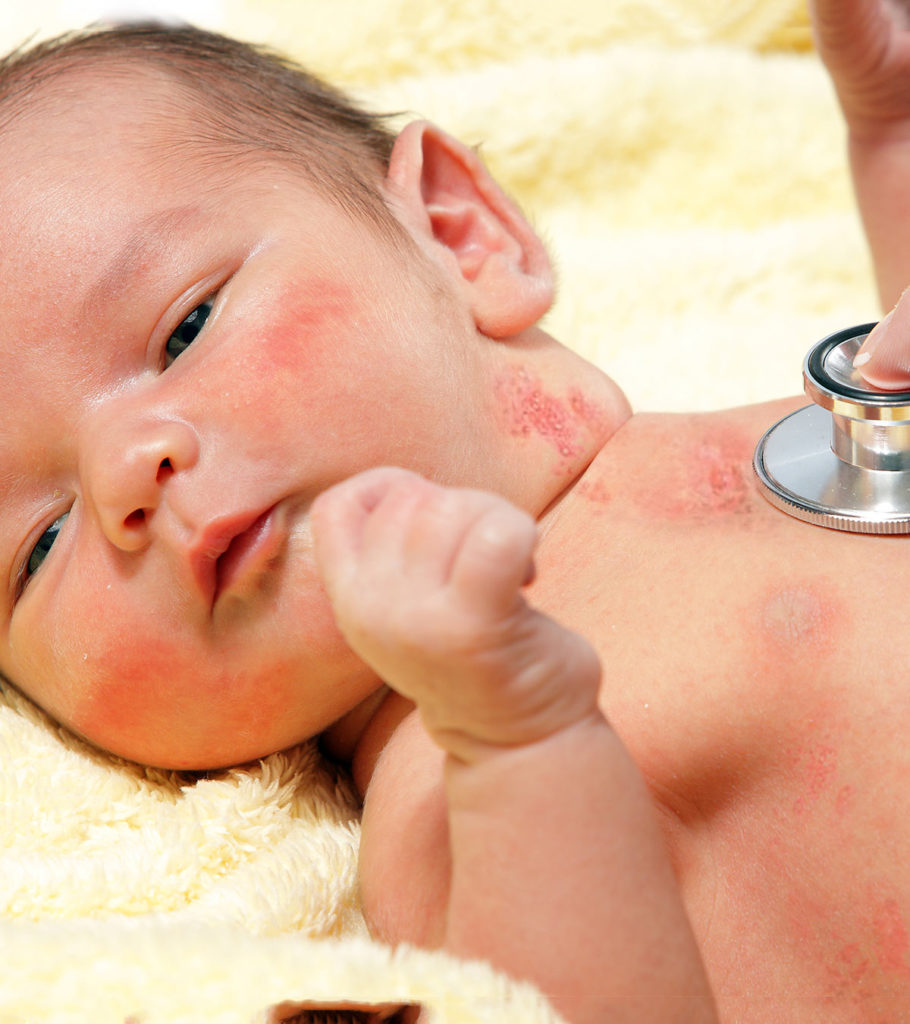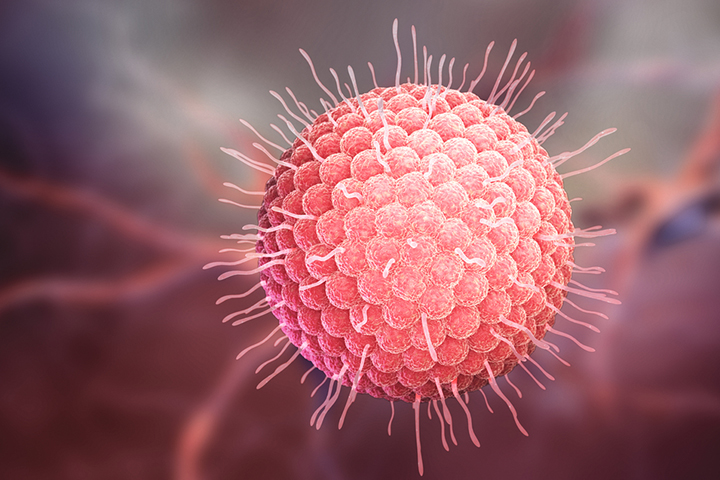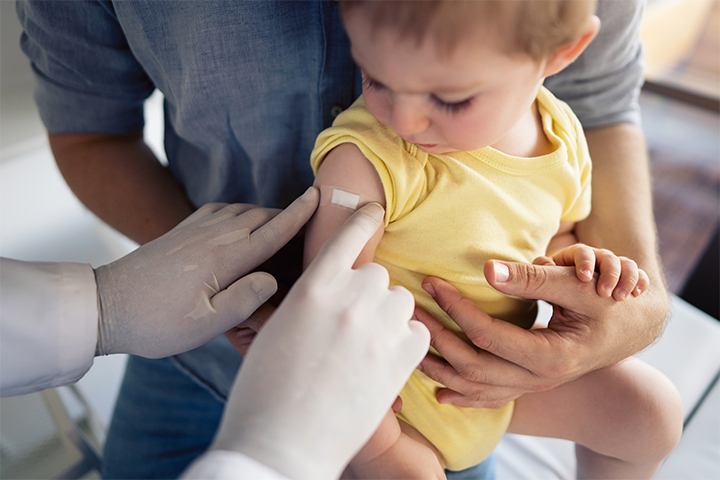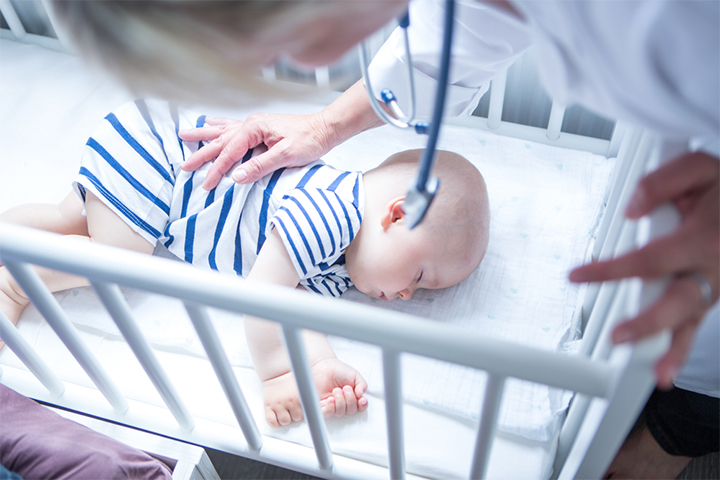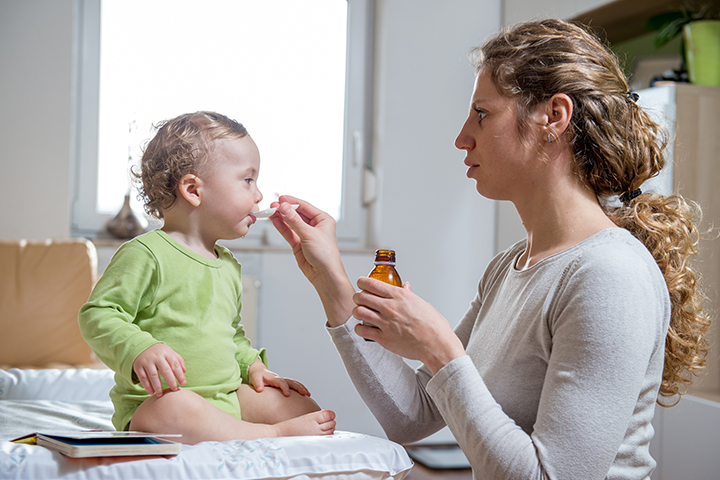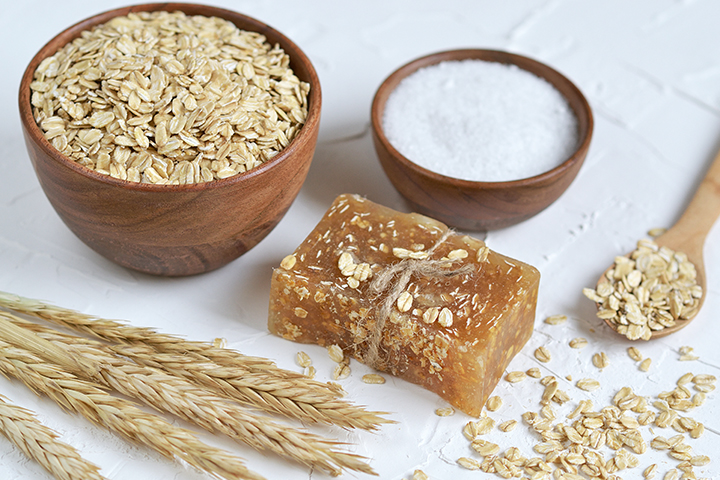The varicella-zoster virus (VZV) causes shingles, a painful skin rash (1). It develops an itchy, painful rash across the torso, which might appear as a stripe of blisters (vesicles) around the sides of the chest and in the back. Shingles in babies are more likely to occur if the baby has already had a history of chickenpox, as the same virus causes both diseases. Continue reading this post to learn about shingles in infants, including its causes, symptoms, and treatment options. We also discuss a few home treatments that may help the infant feel better.
Is Shingles Contagious To Babies?
No. Shingles does not spread from one person to another (2). A baby will develop shingles only if they have been affected by chickenpox in the past, and the dormant zoster virus is reactivated due to weak immunity.
What Causes Shingles In Babies?
Shingles is a viral infection caused by the varicella-zoster virus, which is a pathogen that also causes chickenpox. When a baby suffers from chickenpox, the body’s immune system eliminates the virus and retains an antibody against future attacks. However, some viruses survive and remain dormant in the nerves of the spinal cord for the rest of the life, long after chickenpox is cured (3).
The dormant varicella-zoster virus is kept in check by the immune system and never allowed to multiply. But when the immune system experiences suppression or its efficiency reduces, the virus strikes back, but with shingles. The virus invades nerve and skin cells causing red to dark pink blisters. Shingles is also known as zoster or herpes zoster. The zoster virus is different from the actual herpes virus but belongs to the same family of herpes simplex virus.
Since the condition is triggered by the virus that causes chickenpox, babies who have had chickenpox are likely to develop it.
Are There Risk Factors For Shingles In Babies?
Besides chickenpox, the risk of shingles increases in the below scenarios (4):
- Infants with AIDS and cancers
- Babies who had chickenpox before one year of age
- Newborns whose mothers suffered chickenpox in the third trimester
Both HIV and cancer bring down the efficiency of the immune system, invariably reactivating the zoster virus. Babies who suffer chickenpox early in life may not develop adequate antibodies to suppress the zoster virus. The same is the case with infants who are exposed to the virus during gestation.
Shingles is quite uncommon in babies and most prevalent among the elderly (1). According to the US Centers for Disease Control and Prevention (CDC), those above the age of 60 are at the highest risk of developing shingles, and 50% cases are reported from this age group (5). Furthermore, researchers at the Centers for Disease Control and Prevention (CDC) found that between 2018 and 2019, an average of 1,390 varicella hospitalizations occurred annually, and children aged one to four represented only 6% of these hospitalizations. Though the overall risk of shingles is low in babies, it is essential to learn how to identify the condition.
Can You Prevent Shingles In Babies?
Yes. The disease is preventable. Here is how you can do that:
- Chickenpox vaccine: If the baby never suffered chickenpox, then a chickenpox vaccination or immunization is a good way of preventing shingles. The vaccine is recommended only for infants older than 12 months and protects against the varicella-zoster virus (6).
The first shot is administered between the age of 12 and 15 months, and the booster shot is given between four and six years. The CDC states that the chickenpox vaccine is the best way to protect against the varicella-zoster virus (7).
-
- Shield the baby from those with chickenpox: If the baby never had chickenpox, then you must keep them away from anyone with chickenpox or shingles. Although shingles is not contagious, chickenpox could spread from one person to another. The zoster virus spreads through inhalation of saliva and mucus droplets expelled by an infected person while sneezing or coughing.
Avoid taking the baby to overcrowded places and wash their hands regularly to prevent contracting the virus through the oral route. Maintaining personal hygiene is perhaps the best way, beyond vaccination, to shield the baby from the herpes virus.
There is also a vaccine for shingles, but medical experts and governmental agencies recommend it for adults older than 60 years (8). It is almost never given to babies as shingles does not cause problems among infants at the scale at which it does in the elderly. Exceptions could be made in the case of infants with immunosuppressive diseases.
Prevention is better than cure. Yet, if you doubt that your baby has contracted shingles, look for the symptoms carefully.
What Are The Symptoms Of Shingles In Babies?
When suspecting shingles in infants, one must look for the following symptoms (9):
- Excruciating itchiness and fussiness: Itchiness possibly develops within one to five days after the first shingles rash. The baby will itch or rub the side of their chests, the back of shoulders, and the side of the face. Take a note of the spot where the baby itches, as the rashes would emerge there later. Itchiness would also make the baby fussy.
- Pimple-like rash: A belt or row of rashes resembling pimples would appear only on one side of the body. It means there would be a row of rashes on the side of the chest, face, and back of the shoulders, but only on one side. The other half beyond the midline would be clean.
- The rash turns into a blister: The small rashes turn into red to dark pink blisters that look like multiple boils clustered together. The blistering stage of shingles is the longest and can last for a week to ten days.
- Fever and loss of appetite: Babies may get a fever and have a low appetite. The baby could also have an upset stomach and feel nauseous.
- Tiredness and lethargy: The infant may lack energy, feel drowsy, and have a disinterest in daily activities due to acute fatigue.
The shingles rash dries, turns into scabs, and falls off nearly a month after the emergence of the early pimple-like rash stage. But don’t wait for the entire process. You must take the baby to a doctor right when the first rashes appear.
How Is Shingles In Babies Diagnosed?
Diagnosis of shingles in infants is straightforward and done in the following three steps (10):
Medical history and visual examination: Doctors identify shingles by the appearance of the blister and its location on the body. Parents are asked if the baby suffered from chickenpox in the past or if the mother had chickenpox during pregnancy.
If the diagnosis shows that the baby has shingles, the doctor suggests the treatment options.
How Is Shingles In Babies Treated?
There is no treatment for shingles as it is caused by a virus, and the only solution is to wait for the immune system to overpower it (11). Usually, healthy infants recover in a month from when the first symptoms show, without medications.
In severe cases, the doctor might prescribe some medication to slow down virus replication and ease the symptoms.
A pediatric expert may prescribe the following medicines for shingles in babies (12):
- Antiviral drugs: These medicines, such as Acyclovir, interfere with the virus’s ability to infect healthy cells and bring down the rate of proliferation. It creates an adequate window for the immune system to take charge.
- Fever relievers: The doctor will prescribe acetaminophen and ibuprofen depending on the baby’s age and intensity of fever. No aspirin-like preparations should be given as they cause a complication called Reye’s syndrome.
- Topical ointments: It helps reduce skin irritation and pain. If the baby finds touching the blister painful, the doctor may prescribe a spray version of the drug.
In any case, if your baby had chickenpox in the past, you should take additional steps to prevent contracting the zoster virus. You could also try a few home care tips and remedies to alleviate the symptoms of shingles.
Are There Any Home Remedies For Shingles In Babies?
Yes. These home remedies help alleviate discomfort and bring relief from irritation. They have been recommended by experts and pediatricians (13):
- Dress babies in loose clothing: Since the blisters are itchy, dressing the baby in loose clothes helps prevent friction and thereby, reduce itchiness.
- Cold compresses: Soak a towel in water that is comfortably cold and gently compress the blisters. It will help numb the pain and relieve the irritation. You can perform cold compresses multiple times in a day.
- Oatmeal bath: Mix a cup of fine oatmeal powder in your baby’s bathing water before giving a bath. It will help subdue the irritation. You can purchase plain oatmeal from the market and grind it at home. Alternatively, you can buy unflavored, readymade oatmeal powder.
- Calamine solution: Applying plain calamine solution on the blisters helps reduce itching and creates a cooling effect on the affected skin.
- Lots of rest, proper diet, and breastfeeding: A baby’s immune system can work at its full potential when they get adequate rest and proper diet. If the infant is older than six months, give them a wholesome, balanced diet. Also, your breastmilk offers protection against infections. Experts note that if a mother suffered chickenpox earlier in her life, she could pass her antibodies to the baby through breastmilk (14). It offers passive immunity and helps boost antibody production by the infant’s immune system.
If the baby is younger than six months, then consult a doctor before trying any home remedy.
Vaccinating your baby on time and preventing them from exposure to possible sources of chickenpox might help reduce their chances of contracting shingles. However, shingles are not a contagious disease. Therefore, the risk of acquiring this disease from other children is comparatively less. Dressing your baby in loose clothing and applying a cold compress to the affected areas can be helpful in providing relief to the infant. In addition, ensure that your baby gets proper rest and has nutritious food to aid the recovery process.
Key Pointers
- The varicella-zoster virus causes shingles and chickenpox.
- Shingles is uncommon in babies and causes a painful skin rash.
- Protect babies from shingles by vaccinating them against chickenpox and avoiding contact with those who have it.
- Symptoms of shingles include a rash that turns into blisters, fever, severe itching, lethargy, and loss of appetite.
- Treatment for shingles involves antiviral drugs, fever-reducing medication, and topical ointments to relieve itching.
Shingles are a painful condition, but did you know there are some interesting facts about it? Check out this video to learn a few interesting facts about shingles!
